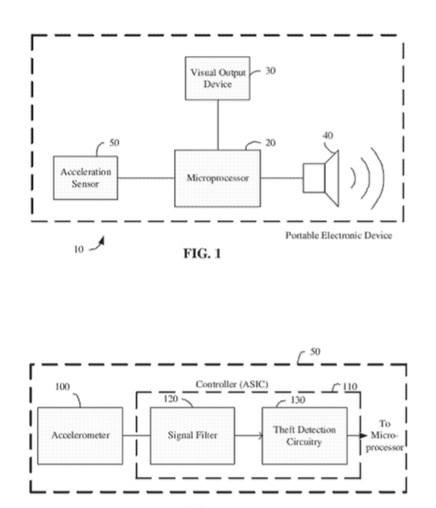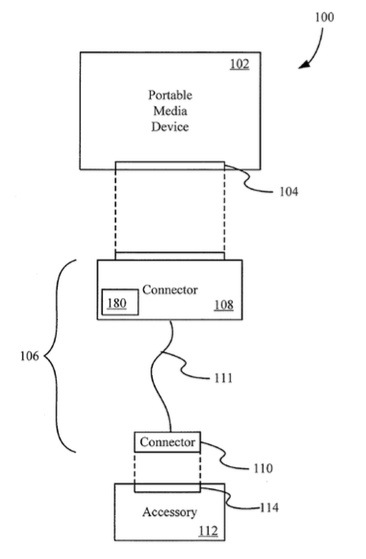A new Apple patent (number 20120278907) at the U.S. Patent & Trademark Office shows that Apple continues to work on new theft detection/prevention technology. The patent is for acceleration-based theft detection system for portable electronic devices.
Per the patent (top graphic), an acceleration sensor detects the acceleration of a portable electronic device, and a controller analyzes this acceleration to determine whether a theft condition is present. If so, an alarm can be initiated. The theft prevention system can include a filter for attenuating irrelevant acceleration frequencies and isolating those representative of theft, and comparison hardware/software for determining whether the detected acceleration matches a known acceleration profile characteristic of theft. Various parameters of the theft prevention system can also be set by a user through mechanisms such as a graphical user interface.
Here's Apple's background on the invention: "The drive toward miniaturization of electronics has resulted in computer-based systems that are becoming much more portable. Current portable electronic devices such as laptop computers, hand-held devices such as cellular telephones and personal media devices, such as the iPod from Apple Computer, Inc., and even devices such as compact disc players, are sufficiently compact and lightweight as to make them easily movable. Unfortunately, such ease of transport also implies ease of theft. While the rightful owner of a portable electronic device may conveniently transport it almost anywhere, so can a thief.
"One current anti-theft system is a simple mechanical lock that attaches to the housing of a device, with a cable that wraps around other objects so as to affix the portable device to these objects. In this manner, portable electronic devices can be effectively tethered to nearby fixtures, making theft difficult. However, such systems suffer from drawbacks. For instance, users are forced to carry around a bulky cable and lock, thus somewhat defeating the purpose of portable electronic devices. Also, users may sometimes wish to leave their devices in areas where there is no convenient fixture to tether to.
"It is therefore desirable to develop a theft detection system for portable electronic devices. It is further desirable to develop a theft detection system that does not require the use of additional bulky physical mechanisms, and which is capable of functioning in many different locations."
Paul J. Wehrenberg is the inventor.
Along the same lines is patent 20120278882 (bottom graphic) for accessory device authentication. Per the patent, an authentication controller coupled to a first communication port of a portable computing device is allowed to provide authentication on behalf of an accessory device coupled to a second communication port of the portable computing device. In one embodiment, a dongle that includes an authentication controller can be coupled with the portable computing device. Accessory devices can also be coupled with the portable computing device through other ports, including wireless ports.
The dongle can provide cross-transport authentication for accessories that do not include authentication controllers. Once the dongle had been properly authenticated, the permissions granted to the dongle port can be transferred to a communication port coupled with an accessory.
The inventors are Gregory T. Lydon and Emily Clark Schubert.
Also appearing today at the U.S. Patent & Trademark Office are:
° Patent number 20120278667 for context-based error indication methods and apparatus;
° Patent number 20120278645 for clock synchronization across an interface with an intermittent clock signal;
° Patent number 20120276951 for a low rise camera module;
° Patent number 201202755921 for decoupling rights in a digital content unit from download;
° Patent number 20120275101 for a battery gas gauge reset mechanism;'
° Patent number 2012027494 for a gimballed scroll wheel.














